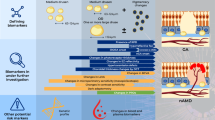Abstract
The duration of diabetes before puberty is not considered relevant to the future development of complications. To evaluate the effects of diabetes on the neural retina, we analysed macular function by steady-state focal electroretinography in 20 prepubescent diabetic children without vascular retinopathy and in 39 sex- and age-matched normal children. The mean (±SD) response related to retinal cellular elements between the photoreceptors and ganglion cells was significantly lower in diabetic children than in the control group (0.38±0.12 vs. 0.51±0.13 μV; unpairedt-test=3;P=0.005). Similarly, ganglion cell function showed a significant impairment in diabetic children with respect to the control group (0.4±0.13 vs. 0.53±0.09 μV; unpairedt-test=5.4;P=0.0001), whereas the photoreceptors appeared unaffected. Metabolic control and disease duration were not correlated with functional deficits. Our results suggest that before puberty, early diabetes may have a selective effect on the neural retina prior to the appearance of microvascular changes. A focal electroretinogram could identify diabetic children with neurosensory disorders who may have a higher risk of developing microvascular retinopathy.
Similar content being viewed by others
References
Davis MD, Diabetic retinopathy a clinical overview. Diabetes Metab Rev 4: 291–322, 1988
Bresnick GH, Diabetic retinopathy viewed as a neurosensory disorder. Arch Ophthalnol 104: 989–990, 1986
Juen S, Kieselbach GF, Electrophysiological changes in juvenile diabetics without retinopathy. Arch Ophthalmol 108: 372–375, 1990
Caputo S, Di Leo MAS, Falsini B, Ghirlanda G, Porciatti V, Greco AV, Evidence for early impairment of macular function with pattern electroretinogram in type I diabetic patients. Diabetes Care 13: 412–418, 1990
Di Leo MAS, Falsini B, Caputo S, Ghirlanda G, Porciatti V, Greco AV, Spatial frequency-selective losses with pattern electroretinogram in Type 1 (insulin-dependent) diabetic patients without retinopathy. Diabetologia 33: 726–730, 1990
Frank RN, Hoffman WH, Podgor MJ, Joondeph HC, Lewis RA, Margherio RR, Machazel DP Jr, Weiss H, Christopherson RW, Cronin MA, Retinopathy in juvenile-onset type I diabetes of short duration. Diabetes 31: 874–882, 1982
Klein R, Klein BEK, Moss SE, Davis MD, DeMets DL, Retinopathy in young-onset diabetic patients. Diabetes Care 8: 311–315, 1985
Weber B, Burger W, Hartmann R, Hövener G, Malchus R, Oberdisse U, Risk factors for the development of retinopathy in children and adolescents with Type 1 (insulin-dependent) diabetes mellitus. Diabetologia 29: 23–29, 1986
Murphy RP, Nanda M, Plotnick L, Enger C, Vitale S, Patz A, The relationship of puberty to diabetic retinopathy. Arch Ophthalmol 108: 215–218, 1990
Porciatti V, Non-linearities in the focal ERG evoked by pattern and uniform-field stimulation. Their variation in retinal and optic nerve dysfunction. Invest Ophthalmol Vis Sci 28: 1306–1313, 1987
Baker CL, Hess RF, Olsen BT, Zrenner E, Current source density analysis of linear and non-linear components of the primate electroretinogram. J Physiol 407: 155–176, 1988
Porciatti V, Falsini B, Fadda A, Bolzani R, Steady-state analysis of the focal ERG to pattern and flicker: relationship between ERG components and retinal pathology. Clin Vision Sci 4: 323–332, 1989
Maffei L, Fiorentini A, Generator sources of the pattern ERG in man and animals. In: Cracco RQ, Bodis-Wollner I (eds) Frontiers in clinical neuroscience, Vol. III. Liss, New York, pp 101–116, 1986
Porciatti V, Falsini B, Scalia G, Fadda A, Fontanesi G, The pattern electroretinogram by skin electrodes: effect of spatial frequency and age. Doc Ophthalmol 70: 117–122, 1988
Baker WS, Hess RF, Linear and non-linear components of the human electroretinogram. J Neurophysiol 51: 952–967, 1984
Brindley GS, Westheimer G, The spatial properties of the human electroretinogram. J Physiol 119: 518–537, 1965
Fiorentini A, Maffei G, Pirchio M, Spinelli D, Porciatti V, The ERG in response to alternating gratings in patients with diseases of the peripheral visual pathways. Invest Ophthalmol Vis Sci 21: 490–493, 1981
Fadda A, Falsini B, Neroni M, Porciatti V, Development of a personal computer software for a visual electrophysiology laboratory. Comput Methods Programs Biomed 28:45–50, 1989
Arden GB, Hamilton AMP, Wilson-Holt J, Ryan S, Yudkin JS, Kurlz A, Pattern electroretinogram becomes abnormal when background diabetic retinopathy deteriorates to a preproliferative stage: possible use as a screening test. Br J Ophthalmol 70: 330–335, 1986
Coupland SG, A comparison of oscillatory potential and pattern electroretinogram measures in diabetic retinopathy. Doc Ophthalmol 66: 207–218, 1987
Porciatti V, Von Berger GP, Pattern electroretinogram and visual evoked potential in optic nerve disease: early diagnosis and prognosis. Doc Ophthalmol Proc Ser 40: 117–126, 1984
Seiple WH, Siegel IM, Carr RE, Mayron C, Evaluating macular function using the focal ERG. Invest Ophthalmol Vis Sci 27: 1123–1130, 1986
Maffei L, Fiorentini A, Electroretinographic responses alternating gratings before and after section of the optic nerve. Science 211: 953–955, 1981
Marano CW, Matschinsky FM, Biochemical manifestations of diabetes mellitus in microscopic layers of the cornea and retina. Diabetes Metab Rev 5: 1–15, 1989
MacGregor LC, Rosecan LR, Laties AM, Matschinsky FM, Altered retinal metabolism in diabetes. I. Microanalysis of lipid, glucose, sorbitol, and myo-inositol in the choroid and in the individual layers of the rabbit retina. J Biol Chem 261: 4046–4051, 1986
Sima AAF, Zhang WH, Cherian PV, Chakrabarti S, Impaired visual evoked potential and primary axonopathy of the optic nerve in the diabetic BB/W-rat. Diabetologia 35: 602–607, 1992
Cryer PE, Gerich JE, Glucose counterregulation, hypoglycaemia and intensive insulin therapy in diabetes mellitus. N Engl J Med 313: 232–241, 1985
Tallroth G, Lingren M, Stenberg G, Rosen I, Agarth C-D, Neurophysiological changes during insulin-induced hypoglycaemia and in the recovery period following glucose infusion in Type 1 (insulin-dependent) diabetes mellitus and in normal man. Diabetologia 33: 319–323, 1990
Author information
Authors and Affiliations
Rights and permissions
About this article
Cite this article
Greco, A.V., Di Leo, M.A.S., Caputo, S. et al. Early selective neuroretinal disorder in prepubertal type 1 (insulin-dependent) diabetic children without microvascular abnormalities. Acta Diabetol 31, 98–102 (1994). https://doi.org/10.1007/BF00570544
Received:
Accepted:
Issue Date:
DOI: https://doi.org/10.1007/BF00570544




